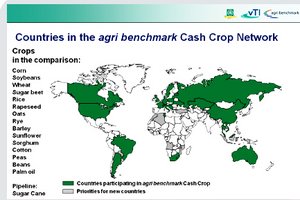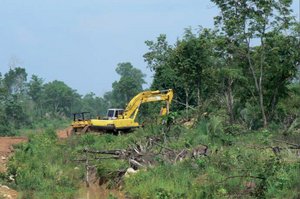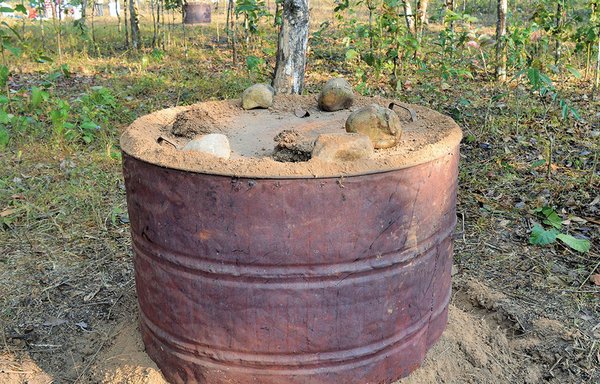 Download this article in magazine layout
Download this article in magazine layout
- Share this article
- Subscribe to our newsletter
Using forest wastes to produce bio-charcoal – A sustainable business model for community forests
In 2016, as much as 76 per cent of Nepal’s energy requirement was met through biofuel and wastes. The felling of trees for firewood and charcoal has had a heavy toll on the country’s rich forest resources. The conversion of the forests’ vast amount of regenerative ground vegetation into carbon rich bio-charcoal could represent an alternative to meet energy demand. Using regenerative forest wastes to produce bio-charcoal would not only help with import substitution of fossil fuel such as coal, liquefied petroleum gas and kerosene, albeit in small amounts, and save the outflow of foreign currencies, it would also create income opportunities for the poor and the disadvantaged while contributing to forest health. Starting in 2014, Helvetas Nepal worked with a set of private value chain actors to build up a sustainable bio-charcoal business model. The four-year initiative has contributed to the management of over 17,500 hectares of forest in 111 community forests.
Better health and higher yield with improved charring kilns
In Nepal, charcoal is traditionally produced by semi-controlled burning of wood in open pits. Working in open pits poses a risk to one’s health as the biomass tends to get contaminated with soil, resulting in dense smoke rising from the ground. This is a particular hazard for the producers, who need to get inside the pit to collect charcoal and are exposed to high respirable particulate matter as well as risking getting burnt. Improved charring kilns, closed containers allowing the controlled burning of the bio-wastes, were therefore introduced by the project. These kilns are easy to handle and less hazardous in terms of fire and particulate matters. Moreover, surveys demonstrated that bio-charcoal yield from the traditionally practised open pit system was 15 per cent, while the improved charring kiln yielded 20 to 25 per cent bio-charcoal. At 6,000 to 7,000 kcal/ kg, the calorific value of bio-charcoal produced in improved charring kilns was 3,000 kcal/ kg higher than that of charcoal produced in open pits.
Bio-charcoal is a carbon-rich product made from biomass, an organic matter of vegetable or animal origin, through its carbonisation under controlled environmental conditions, a process called charring.
The charcoal was produced from forest wastes such as undergrowth, twigs, shrubs and invasive plant species like Mikania micrantha, Eupatorium adenophorum, Eupatorium odoratum and Lantana camara, locally called “banmara”, which, if not cleared from the forests, raise the risk of forest fires, repress natural forest diversity and alter soil nutrient composition. As such, the management of the forests’ bio-wastes was entrusted to the poor and disadvantaged villagers who were also members of Community Forest User Groups (CFUGs), the self-governing entities registered under the District Forest Offices (DFOs) entitled to use forest products. Collected in the process of managing forest health, such forest waste holds an income and employment potential through its conversion to bio-charcoal, while contributing to reducing greenhouse gas emissions.
A private sector-led business model
A business model based on the market systems development approach (see Insert) which was led by the private sector actors of the bio-charcoal value chain – producers, collectors, processors and traders – was applied. Business development service providers (BDSPs) were employed for this purpose. They are a key link in the value chain, working as advisors to facilitate linkages between value chain actors, market and financial institutions. They also helped in developing and implementing the resource management business plans for the community forests (the source of forest biomass);
The Market Systems Development Approach, also known as Making Markets Work for the Poor (M4P) approach, accounts for a market actorsled perpetuating system which is enabled by business-friendly policies and rules, and is facilitated by public and private support functions.
The BDSPs have been integrated into the value chain as collectors or processors or both. They became pivotal in balancing demand and supply, as they could influence both sides of the chain, i.e. production as well as marketing. And it was in their business interest to explore the market, diversify products and invest in their supply chain (on kilns for charring, the price of which is adjusted in the buying rate of the charcoal) to ensure regular supplies of quality bio-charcoal. The BDSPs offered a buyback guarantee for bio-charcoal to the producers, which is much needed by them to engage in bio-charring. Many of the BDSPs/ processors turned raw bio-charcoal into carbon-dense products such as pillows, pellets and briquettes that were relatively longer lasting than raw char and were easier to handle. Mostly, the processed bio-charcoal is used in the gastronomy industry (for tandoori and barbecue) and in households. The powdered bio-charcoal also goes into making incense sticks and is used as a comingled mixture with fossil coal in brick kilns.
Benefits along the value chain
In economic terms, the business model proved to be advantageous to all value chain actors. The bio-charcoal opportunity not only allowed the communities to clear the forest wastes free of cost, but also helped most of the Community Forest User Groups earn some money as royalty from bio-charcoal producers. The royalty ranges from five to ten US dollars (USD) per tonne for the coal produced.
Individuals involved in producing bio-charcoal are mostly the poor members of the CFUGs who have the responsibility to manage the forests – their source of fuel and fodder. This is an opportunity for them to at least make some money in the bio-charcoal producing season (seven months in a year). Their earnings from bio-charcoal production range from about USD 90 to USD 180 per person per month. The flexibility of working hours in running a kiln has attracted many women into charcoal production. From 2014 to 2017, there was a steady increase in the total number of producers, 52 per cent of whom were women. Some women have also learnt to become charring trainers, which is helping to break gender stereotypes (see Quote).
“Kushal hired me as a charring trainer for a training in Kamane, Hetauda. The women participants were happy to see me and said that their confidence had been boosted by seeing me as a trainer, adding that they could also produce charcoal if I was able to.”
Chandra Kala Risal, a charcoal producer of Jhapali Tole,Simara-Jitpur (a Sub-Metropolitan city in southern Nepal).
The collectors, who collect bio-charcoal from producer groups in small quantity and sell them to processors in bulk, make an average profit of USD 5 to 25 per tonne. The profit margins of the processors, who add value to the raw charcoal by diversifying it into different product types, i.e. pellets, pillows, briquettes, etc., vary according to product type. For pillows and pellets, the average margin is around USD 150 per tonne; in briquettes, the mark-up is USD 2 per 100 pieces. For the wholesaler/retailer, there is a mark-up of USD 100 to 200 per tonne at each level of the market.

Good marks for sustainability
A recent review of the bio-charcoal business model shows that it is sustainable from a technological, social, environmental and financial point of view.
The improved charring kiln is locally available and easy to operate. The price is affordable for the economically poor producers – the lowest-priced kiln comes at USD 70. The producers can access the loan for the kilns from micro-finance institutes at a small interest rate or from their own CFUGs (practised in some of the districts), whereby the producers pay off their loan upon the sale of their bio-charcoal in small instalments. As already mentioned, the financing of the kilns by the BDSPs/ processors is an alternative much appreciated by the producers.
The model is contributing to the livelihoods of the poor and the disadvantaged, especially women, by economically empowering them. It is contributing to the revival of bio-diversity and controlling forest fires. The 16 districts where the intervention was carried out offer a potential to produce as much as 90,000 tonnes of bio-charcoal through a small forest management effort. In 2017, these districts produced 8,000 tonnes of bio-charcoal. With the introduction of bio-charcoal, the forest wastes that the CFUGs previously had to pay to get them cleared have now become a source of some income.
The BDSPs have invested heavily in the infrastructure of the value chain with the capacity to produce a multiple of what they are currently achieving. They are looking at the potential for product substitution (LPG, kerosene, fossil coal, etc.) considering the available immense forest resources, international growth of the processed biofuel (PBF) market and the expected conducive policy in the country. Their investments follow their business plan, which was charted in 2016. It covers a period of five to ten years and is indicative of their trust in the profitability and the growth of the sector.
As to environmental sustainability, the incidence of forest fires considerably dropped in the community forests where the interventions were carried out. The findings of the International Centre for Integrated Mountain Development (ICIMOD) suggest that forest fires in the community forests in two of the 16 districts where the intervention was carried out, namely Chitwan and Bara districts, had occurred three times more frequently prior to it.
Rethinking necessary in politics
Despite the obvious benefits, the policy is not explicit when it comes to forest waste-based bio-charcoal. The Nepalese government charges a royalty of 15 USD per 100 kg of wood-based raw charcoal. Bio-charcoal made from invasive plant species harmful to forest health is not differentiated from bio-charcoal produced from timber and as such is subject to the same royalties. Entrepreneurs have found a way to work around the issue of royalty, by including bio-charcoal-related activities in the Operational Plan of the CFUG, which needs approval from the District Forest Office. The issue of royalty exemption and a separate treatment to bio-charcoal produced from invasive species is being advocated by the recently constituted umbrella organisation of the bio-charcoal entrepreneurs, the Bioenergy Entrepreneurs’ Association of Nepal (BEAN).
At policy level, the country’s Biomass Energy Strategy (BES) of 2017 aims at environment and forest conservation through the productive use of biomass as a reliable source of energy in the country’s energy mix, thereby reducing dependency on the imported fossil fuel and in the process creating local employment and income. With these developments, the sector is expected to enjoy a much more conducive environment in the future.

“We used to go to Simla, a north Indian mountain city, to earn money in apple orchards. We could make 100 to 120 US dollars per month, although it was not easy work. A risk of falling from trees while spraying pesticides or plucking apples was always there, one could break one’s limbs. Besides, travel would cost 50 US dollars. Now, we have this alternative. We make 200 to 250 US dollars per month for about eight months a year. And what is best is that we are close to our home, just a district away.”
Gam Bahadur Darlami (left) and Nain Singh Khandalukh (right), both from Nawalparasi District, together with another charcoal producer using the improved kiln.
Niraj Acharya is a rural development professional and currently works as Water and Infrastructure Coordinator at Helvetas Nepal.
Banu Shrestha is a monitoring and evaluation specialist. She currently works as a Monitoring, Evaluation and Learning Officer at Helvetas Nepal.
Sandip Paudel is an enterprise development specialist and currently works as Team Leader for the Elam programme of Helvetas Nepal.
Contact: niraj.acharya@helvetas.org
Acknowledgement
The article is based on the intervention carried out by HELVETAS Swiss Intercooperation in consortium with the International Union for Conservation of Nature and Natural Resources (IUCN), the Asia Network for Sustainable Agriculture and Bio resources (ANSAB), the Sustainable Technology Adaptive Research and Implementation Centre, Nepal (STARIC/N), and Winrock International, which was funded by the European Union.





Add a comment
Be the First to Comment